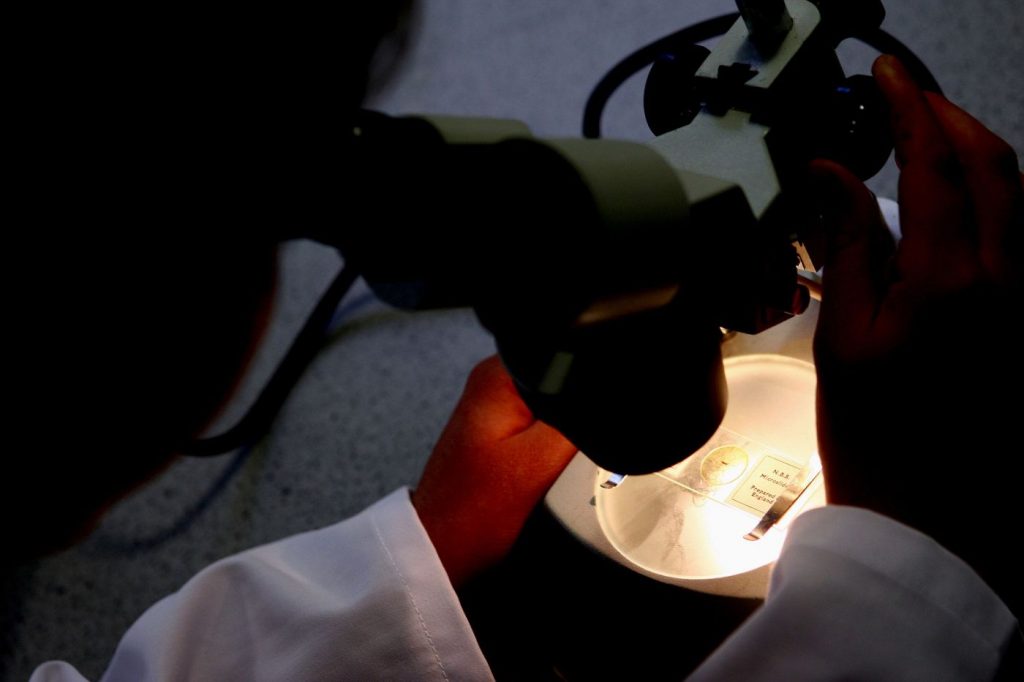After decades of false starts, researchers say they are finally making progress on a long-acting and reversible birth control option for men.
The experimental product is a hormonal gel that men rub on their shoulders once daily. Over time, it blocks the production of sperm in the testes.
The gel was developed by the National Institutes of Health and the nonprofit Population Council, and it takes much the same approach as birth control pills for women. It uses two hormones: nestorone, a progestin, and testosterone, the male sex hormone. The nestorone suppresses the production of testosterone in the testes and, with it, the development of sperm.
But testosterone serves many functions in the body: It is responsible for muscle maintenance and libido, for example, and men need some in their circulation to function normally. The gel replaces enough to keep them healthy but not so much that they make enough sperm to get someone pregnant.
Researchers have been formulating and refining the dose and concentration of the gel since 2005. In this latest test, which included more than 300 couples, they think they got it right.
Normal sperm counts range from about 15 million to 200 million sperm per milliliter of semen, and studies have shown that sperm counts of less than 1 million per milliliter are low enough to prevent pregnancy.
In a clinical trial, 86% of men achieved these low sperm counts by 15 weeks of using the gel. For some, it worked even faster, suppressing sperm production within four to eight weeks.
“We’ve been just really excited by the results. The combination seems to provide better, faster suppression than we expected,” said Diana Blithe, branch chief of the NIH’s National Institute of Child Health and Human Development, who gave an update on the trial results this week at the annual meeting of the Endocrine Society in Boston.
Blithe declined to say whether there were any unintended pregnancies during the trial. The researchers hope to have the final data published in a medical journal, and she said she didn’t want to give away the results.
“I would say our expectation was that it would be similar to hormonal birth control pills. And I can just say that it’s much, much better than that,” she said.
With typical use, birth control pills, rings and patches for women have failure rates of about 7%, meaning 7 women of every 100 who use the method for a year will get pregnant. Condoms have a failure rate of about 13%.
The gel also seems to have other advantages over female birth control. For example, if a woman misses a day or two of the pill, she can ovulate, making it more likely that she’ll have an unintended pregnancy.
With the gel, if a man’s sperm production is fully suppressed and he misses a day or two of usage, his hormones would start to recover, but it takes about 8 to 10 weeks for a man’s sperm count to recover to levels that would cause a pregnancy.
Blithe says that in clinical trials, the researchers are not seeing the kind of mood swings and depression that women can experience with birth control pills, either.
“I would say that there’s a small percentage who have mood swings that they don’t like, but that’s it’s a relatively small number. And we’ve actually been surprised at how few,” she said.
The World Health Organization tested injections that used a similar combination of hormones. The approach seemed effective, but the study enrollment was stopped early, in 2011, because the shots caused too many side effects, including serious depression.
Blithe said that was because the hormones were clearing at different rates when injected. With the gel, a concentration of hormones seems to build up in the skin and create a reservoir that releases more slowly.
“That fluctuation is not really happening, so we’re not creating ups and downs,” she said.
Matthew Treviño, 35, of Sacramento, California, participated in the study. He rubs a little gel on each shoulder first thing in the morning and says it’s become as routine as showering and brushing his teeth.
Aside from a little weight gain, he’s had no complaints, he said. If anything, his sex drive has increased.
“I’ve only experienced increased libido,” he told the “Unfold” podcast, which is produced by the University of California at Davis, which was also one of the study sites. “Maybe I’m just lucking out, but I hope this is the case for the majority of participants. If it is, it’s definitely going to change contraception as a whole.”
To participate in the study, couples had to be in committed relationships, and they signed on for a two-year commitment to the research.
Men are warned that they could experience a number of side effects from the gel, including dry or oily skin, increased or decreased libido, hair growth or loss, and mood swings.
For Treviño’s partner, Emily Fletcher, 28, participating in the research meant giving up her own birth control – an IUD – and taking a big leap of faith right around the time the US Supreme Court overturned Roe v. Wade.
“I was worried,” she told “Unfold.” “There was still a thought in the back of my mind that ‘maybe this will be an issue if the drug doesn’t work, and I get pregnant.’ “
Fletcher and Treviño, who are both researchers at UC Davis, ultimately felt like it was important to participate in the study.
Treviño told the podcast he’s been interested in a male contraceptive for a long time. To him, it doesn’t feel fair that his partner has to shoulder the burden of birth control.
Related Articles
How shots instead of pills could change California’s homeless crisis
Get your health care through Covered California? Beware of this tax peril
Elizabeth Holmes’ appeal set to be heard Tuesday in federal court
FDA panel rejects MDMA as a treatment for PTSD
El Camino Health hires new chief operating officer
Women release an egg only once a month, on average, whereas men produce about 1,000 sperm every second.
“Maybe the burden is on the wrong side,” Treviño said. “I kind of think it’s unfair that it only lands on the women.”
After men stop using the gel, their sperm count returns to normal levels within two or three months. After the recovery phase of the trial, many of the participants went on to become fathers, proving that the method is fully reversible, Blithe said.
That’s a big step forward. Right now, the only birth control options for men are condoms, which have a high failure rate, and vasectomy, a surgical procedure that can be hard to reverse.
The researchers have started a conversation with the US Food and Drug Administration about how to test the gel in a final definitive trial. No male contraceptive method has ever made it this far, Blithe said.
Normally, drugs that make it to this stage have to be compared head-to-head against a placebo. But testing a true placebo in research where the goal is to prevent pregnancy just wouldn’t be ethical, said Dr. Christina Wang, a co-principal investigator on the trial, who specializes in male reproductive biology at the Lundquist Institute at UCLA’s Harbor Medical Center.
If the researchers get the FDA’s nod for a trial, they hope to start the final phase of testing in 2025. It will take another couple years, and Wang said they’ll probably expand the study to more locations and recruit more couples.
Big trials usually require significant investment, too. Blithe says she’s hopeful they’ll get interest from pharmaceutical companies.
Dr. Brian Nguyen, an obstetrician-gynecologist at the University of Southern California who has been involved in helping participants with the social and behavioral needs during the trial, says he’s looking forward to seeing the gel come to market and usher in a new era of gender equity in birth control.
“We often think of men as kind of not being aware or not wanting to be involved. But when you think about men who are in very close partnerships, how does a female partner hide the fact that they are either in pain, or they’re having abnormal bleeding, or mood swings?” he said. “It’s a couples-driven medication, which is very unique.”
The-CNN-Wire
& © 2024 Cable News Network, Inc., a Warner Bros. Discovery Company. All rights reserved.


